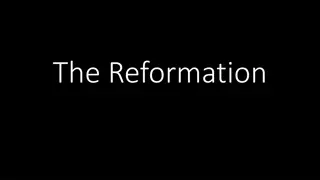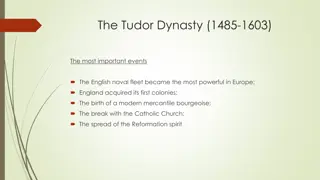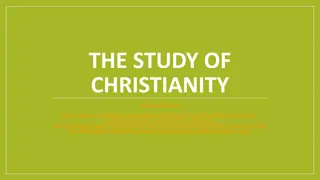Influence of Renaissance and Reformation on English Language Growth
The Renaissance and Reformation had significant impacts on the English language with changes in vocabulary, standardization of language, and spelling, influenced by Latin and religious terms. The Renaissance introduced Latin words, while the Reformation led to the translation of the Bible into Engli
5 views • 5 slides
The Protestant Reformation: Martin Luther and Key Points of Lutheranism
The Protestant Reformation led by Martin Luther in Germany during the 16th century was a religious movement that challenged the authority of the Catholic Church, giving rise to Protestant Churches. Luther's 95 Theses criticized the sale of indulgences and initiated reforms. Key causes included cleri
5 views • 16 slides
Influence of Renaissance and Reformation on English Language Growth
The Renaissance, starting in Europe, and followed by the Reformation, had significant impacts on the growth of the English language. The influx of Latin words, changes in vocabulary, growth of a standard language, and establishment of new coinages are some key outcomes. The Reformation, in particula
2 views • 5 slides
Counter- or Catholic Reformation?
The debate surrounding the Catholic Reformation questions whether it was a self-initiated response to internal factors or a reaction to the Protestant Reformation. Historians differ on when reform truly began, with some arguing it started before Luther. Key questions include whether the Catholic Chu
0 views • 18 slides
Religious Policies of Queen Elizabeth I: Seeking a Middle Way
Queen Elizabeth I of England navigated religious turmoil by establishing a middle way that balanced Protestant and Catholic elements. Her reign saw the passing of acts like the Act of Supremacy and Act of Uniformity to consolidate her power and create a distinct Church of England. Despite facing opp
0 views • 21 slides
Shift of the Church: Eastward Expansion Through History
The Asian Church is witnessing a significant shift in influence from the West to the Majority World, marking a transformative phase in modern mission movements. With historical milestones like the Roman Catholic presence established in 1493 and the Protestant movement beginning in 1705 through figur
0 views • 12 slides
Elizabethan Religious Settlement: Unity Amidst Division
Amid religious division in England, Queen Elizabeth I implemented a Religious Settlement in 1559 to unify the country. The settlement, a blend of Protestant and Catholic elements, aimed to maintain peace and prevent rebellions. Elizabeth's strategic compromise pleased most people, though lingering t
0 views • 14 slides
Insight into the Autobiographical Play "Sailmaker" by Alan Spence
Alan Spence's play "Sailmaker" delves into the poignant narrative of loss, familial struggles, and societal perceptions. Set in a staunchly Protestant culture of Glasgow, the play weaves a tale of Davie, a sail-maker, and his son Alec as they grapple with grief, adaptation, and personal transformati
1 views • 8 slides
Hermeneutics and the Reformation: Principles and Methods
The Protestant Reformation aimed to reform the Church by emphasizing biblical teachings over church tradition. It challenged the authority of the Roman Catholic Church and upheld principles such as Sola Scriptura, Sola Fide, Sola Gratia, Solo Christo, and Soli Deo Gloria. These principles emphasized
0 views • 31 slides
The Impact of the Reformation on European History
The Reformation brought significant changes to theology, religious institutions, and culture in Europe. Reformers like Martin Luther and John Calvin criticized Catholic abuses, leading to new interpretations of Christian doctrine. The Catholic Counter-Reformation and conflicts among religious groups
1 views • 4 slides
Exploring the Renaissance: Art, Music, and History
The Renaissance, spanning from 1400 to 1600 AD, was a period of significant cultural and artistic growth in Europe. Beginning in Italy and gradually spreading across the continent, this era saw advancements in art, music, literature, and technology. Notable figures like Michelangelo, Leonardo da Vin
0 views • 23 slides
The Reformation Parliament and the Break with Rome
The Reformation Parliament played a crucial role in enforcing the break with Rome through various key statutes, such as the Act in Restraint of Appeals in 1533. This pivotal legislation not only granted Henry VIII the power to decide marriage cases within the realm but also made a radical statement
4 views • 12 slides
Analysis of American Identity and Immigration Policies Under President Trump
The analysis delves into Trump's perspective on American identity, focusing on Anglo-Protestant culture and his views on immigration policies. It discusses his beliefs on loyalty, citizenship, and the impact of immigrants on the country. The narrative also touches upon challenges concerning national
1 views • 23 slides
European Political Situation in 1635
In 1635, Europe was embroiled in political turmoil with various regions grappling with debt, overspending, and military conflicts. France experienced a significant increase in revenue but faced challenges due to high military spending. Saxony and the Holy Roman Empire struggled with mounting debts a
2 views • 26 slides
Understanding Love: Agape versus Eros in Christian Thought
Exploring the profound concepts of Agape and Eros in Christian theology, this content delves into the works of C.S. Lewis and Anders Nygren on the meaning of love. Nygren's ideas sparked scholarly debates in the 20th century, shaping Protestant and Roman Catholic thought. Themes of love, happiness,
0 views • 52 slides
The Renaissance and Reformation in Italy: A Historical Overview
The Renaissance and Reformation in Italy marked a period of rebirth and transformation between 1350 and 1550. The Italian Renaissance saw a resurgence of interest in ancient Greek and Roman cultures, characterized by urban growth, secular viewpoints, and a focus on individual ability. City-states li
0 views • 91 slides
Analysis of Staging the Spirit in Shakespearean Drama
Exploring the significance of staging spirits in Elizabethan drama, particularly in Hamlet, sheds light on how Shakespeare cleverly blended Protestant and Catholic viewpoints through characters like Horatio and the ghost. The meeting between Hamlet and his father's spirit marks a pivotal moment in t
0 views • 14 slides
Development of High Entropy Alloy-Based SOFC Anode for Controlled Reformation
Development and testing of a High Entropy Alloy-based Solid Oxide Fuel Cell (SOFC) anode for controlled reformation to improve thermal performance, reduce carbon deposition, and enhance durability. The project involves fabricating cells, electrochemical testing, modeling reformation rates, and scali
0 views • 32 slides
Criticisms and Challenges to the Pre-Reformation Church
Various forms of anti-clericalism and criticism were directed towards the pre-Reformation church. Hieronymous Bosch's "The Haywain" and Chaucer's Canterbury Tales depict cynicism towards corrupt church officials. The Richard Hunne case highlighted Erastian anti-clericalism, while Simon Fish's "A Sup
0 views • 22 slides
The Intriguing Life of Mary, Queen of Scots
Mary, Queen of Scots, posed a significant threat to Elizabeth I due to her claim to the English throne, turbulent marriages, and religious conflicts. Despite facing challenges such as Protestant uprisings and controversial marriages, Mary's tumultuous life ultimately led to her imprisonment and plea
0 views • 11 slides
Queen Elizabeth I of England - A Brief Overview
Queen Elizabeth I of England, known as the Virgin Queen, ruled during the 16th century. She was the daughter of King Henry VIII and Anne Boleyn, and her reign saw England firmly establish as a Protestant country. Elizabeth I was a successful queen who controlled the political and religious landscape
0 views • 8 slides
Henrician Reformation of 1536-47 - Overview of Key Terms and Influences
The Henrician Reformation of 1536-47 was a period of religious change in England, involving shifts in beliefs, worship practices, and organizational structures. This reform was driven both from above, by rulers imposing changes, and from below, with support from ordinary people. Key terms such as Re
0 views • 24 slides
Understanding Henry VIII's Impact on the Church and the Dissolution of the Monasteries
Explore how Henry VIII changed the Church from Catholic to Protestant, leading to the Dissolution of the Monasteries. Learn about key events like the Break with Rome, Act in Restraint of Appeals, and the Royal Supremacy Acts. Understand the roles of monasteries, the causes and consequences of their
0 views • 24 slides
European Renaissance and Reformation: A Time of Innovation and Transformation
The European Renaissance and Reformation period from 1300-1600 was a time of significant change and progress in art, learning, and religion. The Renaissance brought about a rebirth in art and human potential, with a focus on secular achievements and the support of patrons. Meanwhile, the Reformation
0 views • 29 slides
The Thirty Years War: Bohemian Revolt and European Conflict
The Thirty Years War began as a clash over political and religious issues with the Bohemian Revolt in 1618. Despite initial intentions for limited involvement, major powers were drawn into a prolonged conflict lasting three decades. The war involved various factions, including Protestant assemblies,
0 views • 20 slides
Reformation and Counter-Reformation in the Catholic Church
Catholic rules during the Middle Ages granted immense power to the Pope, sparking dissent that led to the Protestant Reformation. The Counter-Reformation was the Catholic response to Protestant criticisms, leading to the Council of Trent in the mid-16th century to reaffirm Catholic doctrines and pra
0 views • 14 slides
Insights on Faith and Contrition from Walther's Teachings
Walther emphasizes the importance of contrition while highlighting that it is not the cause of something specific. He distinguishes between the desire to come to Jesus and the desire to experience contrition. The context also discusses historical aspects like Rationalism in the Protestant Church of
0 views • 20 slides
Tudor Rule: Challenges and Policies of Henry VII and Henry VIII
The Tudor monarchs, Henry VII and Henry VIII, faced various challenges such as rebellions, foreign policy issues, financial management, and religious changes. This content explores the threats to Henry's rule from Yorkist challenges, the success of Henry VII's financial policies, handling of the nob
0 views • 11 slides
The Tudor Dynasty (1485-1603): Key Events and Figures
The Tudor Dynasty (1485-1603) marked significant events in English history, including the rise of the powerful English naval fleet, acquisition of colonies, birth of the mercantile bourgeoisie, break with the Catholic Church, and spread of the Reformation spirit. Economic changes saw the transition
0 views • 5 slides
Christian Denominational Cooperation in IBT: A Unique Collaboration
Institute for Bible Translation (IBT) in Russia/CIS fosters cooperation between Christian denominations to serve non-Slavic communities. Established in 1973, IBT translates the Bible into multiple languages, working with Orthodox, Protestant, and other partners. Despite its scholarly focus, IBT symb
0 views • 11 slides
Key Players and Events in the English Reformation
Explore the key figures and events that shaped the English Reformation, including Henry VIII, Cromwell, Cranmer, and Anne Boleyn's roles in the break with Rome. Analyze the significance of Katherine of Aragon's refusal to accept divorce, Cromwell's influence, and Henry VIII's desires. Evaluate why A
0 views • 6 slides
The Protestant Reformation and Its Impact on the Church
The Protestant Reformation was a period of religious upheaval in the 16th century, marked by criticism of the Roman Catholic Church's practices and beliefs. Martin Luther challenged the church by advocating salvation through faith alone and rejecting certain traditional practices. John Calvin emphas
0 views • 16 slides
The Reformation: Beyond Luther and the Radical Reformation
Explore the Reform movement beyond Martin Luther, delving into the radical beliefs of Anabaptists and the Magisterial Reformation led by Luther, Calvin, and Zwingli. Uncover the significant differences in theology, practices, and beliefs that shaped Christianity during this transformative period. Wi
0 views • 17 slides
The Protestant Reformation and its Impact on Europe
The 16th-century Protestant Reformation was a result of humanism and intellectualism, challenging the authority of the Catholic Church. This movement led to a revolution in religious thought, shaped identities, and contributed to the development of modern democracy. Calls for reform from figures lik
0 views • 21 slides
Understanding Justification by Faith in Christianity
The study of Christianity delves into the complex relationship between faith and works, particularly focusing on the concept of justification by faith. Explore the significance of Martin Luther's teachings on justification and the impact of his ideas on the Protestant Reformation.
0 views • 28 slides
Martin Luther and the Lutheran Church: History and Beliefs
Martin Luther, a key figure in the Protestant Reformation, laid the foundation for the Lutheran Church with his teachings emphasizing Grace Alone, Faith Alone, and Scripture Alone. This summary touches upon Luther's early life, his theological insights, and the famous 95 Theses that challenged the R
0 views • 10 slides
The Tudor Dynasty: Henry VIII, Reformation, and the Creation of the Church of England
Explore the rich history of the Tudor dynasty with a focus on Henry VIII, the Protestant Reformation in Europe, and the pivotal creation of the Church of England. Learn about key events such as Henry VIII's marriages, his quest for a male heir, the beginnings of Protestantism in England, and the est
0 views • 11 slides
Diverse Perspectives on the Protestant Reformation
Exploring key events and figures of the Protestant Reformation, from the theological debates between Luther and Zwingli to Calvin's influence in Geneva. The narrative delves into the international impact of Calvinism, the Council of Trent's response, and the Elizabethan Reformation's significance. I
0 views • 10 slides
The Reformation and John Calvin: A Journey of Faith and Reform
Discover the compelling story of John Calvin and the Reformation movement, from his early life to his pivotal role in reforming the Roman Catholic Church. Explore his conversion, writings, and impact on Christian theology.
0 views • 9 slides
Settling the Northern Colonies: Religious Transformation and Colonization
The Protestant Reformation led to the emergence of Puritanism in the Northern Colonies, with figures like Martin Luther and John Calvin shaping religious beliefs. The Massachusetts Bay Colony stood as a beacon of self-government and religious ideals, while dissenters like Anne Hutchinson and Roger W
0 views • 9 slides







































